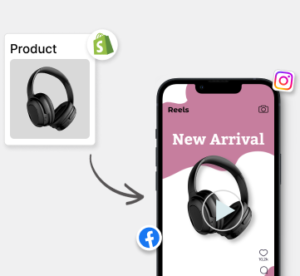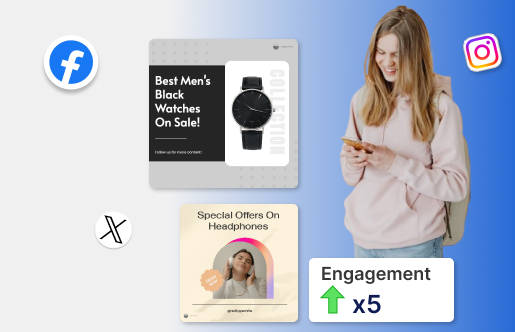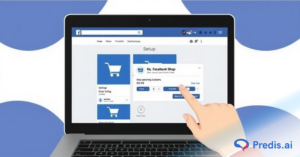Wouldn’t it be nice that the customers who visit your site always leave with a cartful of purchases so that you don’t become the victim of Shopping Cart Abandonment?
To begin, you must attract customers using a variety of marketing methods. But at any point along the buyer’s journey, they may abandon the cart and fail to finish the next step, losing you a sale.
Shopping cart abandonment is so common that it costs online retailers approx. 4.6 Trillion USD worldwide. And, in eCommerce, a high shopping cart abandonment rate equals lost sales.
If you are also struggling with this issue in the e-commerce world, don’t look further, this article discusses everything about shopping cart abandonment, its primary reasons, and how to avoid it. Let’s get started!
What is Shopping Cart Abandonment?
Shopping cart abandonment occurs when a potential customer adds products to his/her shopping cart and starts the check-out process for making a purchase. But due to some change of mind, quits the process before a successful checkout. The shopping cart abandonment rate is a critical indicator for eCommerce sites. It helps in monitoring since a high abandonment rate signals a bad customer experience.
The rate assists in determining the percentage of users that begin with a buying intent but do not finish the transaction for any reason. Reducing cart abandonment increases sales and profit revenue. As a result, streamlining the checkout flow should be the first priority of online shops. You can use the following formula to calculate the cart abandonment rate:
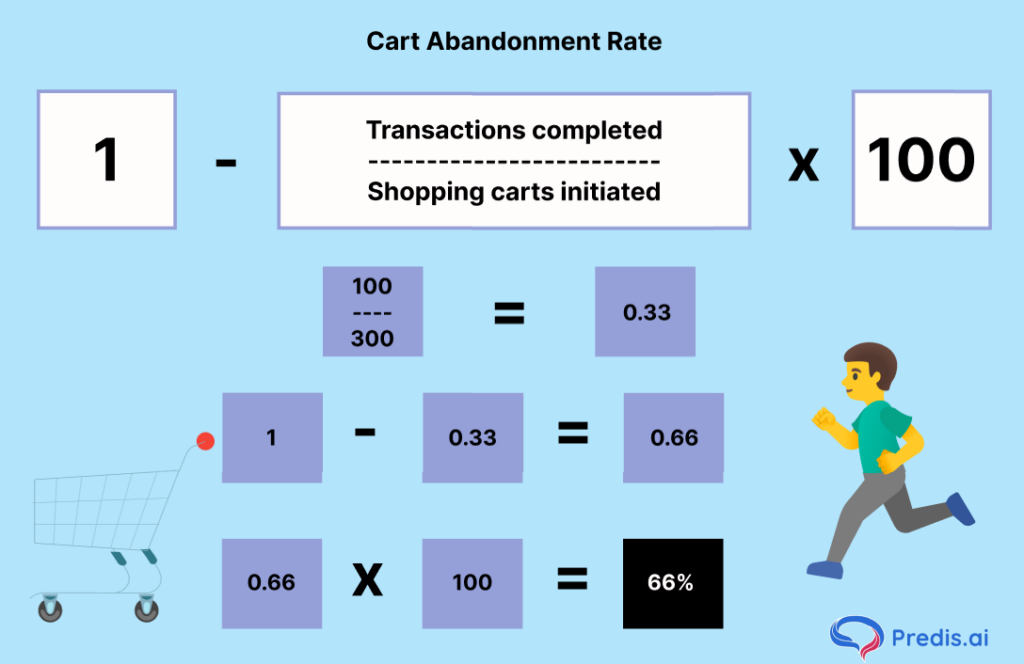
4 Most Common Reasons Behind Shopping Cart Abandonment
According to the Baynard Institute, half of all customers quit their carts when they see hidden charges such as shipping, tax, and fees. It was discovered to be the leading cause of abandoned shopping carts.
Furthermore, 28 percent of customers abandon carts because the site requires them to establish an account. Therefore, it is the second most common reason shoppers do not complete their transactions.
Your items may be exactly what your clients are seeking. Don’t let little details that you’re neglecting be the reason you’re losing sales. Here are some of the most important shopping cart abandonment causes to be aware of –
1. Complex Checkout Process
One of the most common reasons for shopping cart abandonment is a lengthy and complicated checkout procedure. More steps impede and complicate the user’s ability to complete payment. Customers want a straightforward, convenient procedure; thus, any extra steps detract from the user experience.
2. Poor UI & Website Performance
Unexpected website performance issues, such as crashes or delayed loading, result in a bad user experience. Customers often prefer quicker and more seamless purchasing experiences.
3. Unexpectedly Higher Shipping Charges
When hidden charges are added when a buyer adds an item to the basket, the customer reconsiders purchasing the item. The additional fees and taxes deter customers from completing a final purchase.
4. Product Unavailability At The Selected Location
One of the most annoying causes for online cart abandonment is discovering that the product is now out of stock. That too, for their selected location. This reflects a bad client experience because of the time they lost. However, it also reflects badly on the mechanisms in place at your company.
When a customer discovers a product is out of stock in their area after investing time in checking out, they’re unlikely to return to your business. This is especially true if it is their first visit.
Preventing shopping cart abandonment in your online business is achievable. This is more likely when you consistently maintain your item stock. It also involves understanding the pace at which you need to re-stock. Also, keep in mind that your online store should properly mark out-of-stock items so that potential buyers do not waste their time and link your business with a bad purchasing experience.
Why Shopping Cart Abandonment is a Major Problem That Retailers Must Encounter?
Shopping cart abandonment has long been a major issue for businesses, affecting many aspects of their operations. Shopping cart abandonment has a wide range of implications. These implications include its impact on sales, conversions, and income. It affects companies on a regular basis.
As a result, it is critical for merchants to limit the impact of cart abandonment to a minimum while maintaining a profit. Shopping cart desertion is a concern for merchants for a variety of reasons –
- When shops have digital shopping cart abandonment impacts on inventory as a result of unnecessary cart loading and subsequent abandonment, genuine customers may encounter the problem of product unavailability.
- Revenue loss is fairly prevalent with online shops that suffer from the negative impacts of shopping cart abandonment more frequently than they would want.
- Stores that are affected by shopping cart abandonment are obliged to adjust their marketing and price tactics, resulting in a loss of capital on labor.
- Cart abandonment on a frequent basis can place a load on servers, causing servers to slow down and, as a result, consumers to have a bad UX.
15 Noteworthy Ways To Reduce the Shopping Cart Abandonment
Shopping cart abandonment can occur due to a variety of factors, all of which can have a negative influence on sales income. When determining how to avoid abandoned carts, the essential elements to examine are why customers leave without purchasing and what you can do to fix it.
Let’s look at some concrete steps you may take to mitigate the negative consequences of digital shopping cart abandonment.
1. Make Your Checkout Process Smoother
Reduce the payment procedure to as few stages as feasible so that it may be completed in the blink of an eye. On your checkout pages, offer a progress indicator or bar so customers can see exactly what the process looks like and how long it will take.
Pressing the “next” button repeatedly without understanding where it leads might easily result in customers giving up and putting their money elsewhere.
Consider that customers are buying on a variety of platforms, including mobile, laptop, desktop, and tablet. Make the checkout experience as seamless as possible on all devices, and ensure that the design takes into account all screen sizes and dimensions.
2. Offer Different Payment Options To Your Customers
Another simple solution that might be the difference between missing out on a sale and cashing in is having various payment alternatives. Make sure you offer as many payment options as possible so that customers may select the one that works best for them at the moment. It makes everyone feel attended to, and you gain perceived credibility as a result.
To earn your clients’ trust, display security badges or logos as close to transaction forms as feasible. Customers will not feel safe if they are required to enter personal and credit card information onto a site they believe lacks crucial trustworthy information.
3. Provide Real-Time Assistance To Your Customers
Implementing live chat may significantly increase sales. It is a good route for increasing conversion rates and maximizing ROI. It enables clients to communicate with agents in real time and receive immediate responses, allowing them to make swift sales choices. According to 63 percent of respondents, customers are more likely to return to a website that provides live chat than one that does not.
Over reactive communication mediums, live chat is one of the most desired. As a result, adopting live chat may be a critical aspect in increasing conversion rates by giving real-time sales support.
4. Don’t Force Your Customers To Subscribe
You wouldn’t want to be forced to sign up for a newsletter if you were shopping at a physical store, so why force it on your online customers?
Customers will sign up to get your messages when they are ready, so keep up the good work, and they will naturally follow if they want more. Maintain the opportunity to sign up and incentivize with discounts or discount codes, but don’t force it on your clients or make it mandatory.
5. Put Clear CTAs On Your Website
Make it simple for customers to traverse the path to buy. Another critical consideration is page speed. According to Fundera, if your site takes too long to load, cart abandonment might rise by 75%. Customers who do not have enough time will not wait for your pages to load, so make this a priority.
Make it clear to customers where they should click and where they will reach if they do so. Nothing is more frustrating than being inundated with messaging and buttons or becoming lost in the plethora of pages, text, and graphics that many businesses offer.
Boost Sales on Social Media with AI ⚡️
TRY NOW6. Enable The Automatic Cart Save Option
Customers will be dissatisfied if they spend time constructing their shopping basket only to return in a few hours to find it has expired. Make cart saving simple, or offer to save cart contents automatically.
With the different channels and devices clients use to shop nowadays, you must ensure that a cart is saved and that the same cart appears on any of the various devices the customer is using.
7. Allow Your Customers To Track Their Orders
You want to demonstrate that you are a transparent company that strives to deliver orders to consumers as promptly as feasible.
Customers will not be forced to hang around and wonder where their order is if they have access to a delivery timetable and can observe the process and each step being fulfilled.
Allow clients to opt for an email or SMS notification when their order is ready, in transit, or on its way. By providing this, you are also reducing your workload of manually responding to inquiries regarding the status of your client’s orders at each stage of the process.
8. Don’t Hide Your Shipping Charges
It is critical to be open and honest about any delivery fees and other expenditures. A last-minute expense that appears just before the last step of the purchasing process will irritate customers and almost certainly result in a lost transaction.
For example, a customer looking at metal building prices might find an affordable base price, but unexpected shipping costs may deter them from completing the purchase. Therefore, it’s a good idea to clearly display all costs, from materials and labor to shipping and delivery, to ensure a positive experience and build trust.
If possible, give free delivery, even if it slightly raises product pricing. It’s all in how you phrase it, and customers will feel much more comfortable making a purchase from a business that offers free delivery.
9. Provide a Refund Option And Money-Back Guarantee To Your Customers
As an eCommerce company owner, you don’t want your clients to be skeptical or cautious. To provide value to customers, you must investigate and execute shopping cart abandonment solutions.
You are symbolically standing with them during the buying process by offering a money-back guarantee. Although it also assures them that everything will be fine. This method can also help you enhance your store’s online sales.
When your customers can’t touch or see the goods in person, there’s an element of risk involved. They want to know that if they make a mistake and pick something they subsequently regret it. However, they can quickly reverse the transaction at no additional cost.
10. Retarget Your Lost Customers
When you employ retargeting, you are bringing qualified leads back to your online business. This may have an even greater impact when the retargeting advertisements are customized.
Throw away the generic advertising and try to retarget your customers with the specific goods they were looking at or adding to their cart.
Retargeting is a narrow line between stalking and reminding your consumers about their cart. It also provides easy access to goods they previously expressed interest in. When checking out carts, the goal is to replace the possible sensation of frustration with ease.
According to a study conducted by 99firms, engaging in retargeting advertisements for clients who have abandoned their carts may increase conversion rates from 8% to a stunning 26%.
Boost Sales on Social Media with AI ⚡️
TRY NOW11. Reach Out To Users With Their Shopping Cart Status And Nudge Them To Buy/Offer A Small Discount
If you individually contact a customer through email to inquire about why they abandoned their basket, you may discover that their card information was invalid or that a promotional code they had was not approved.
Solving these difficulties and offering personalized shopper attention can help your brand’s image. On the other hand, it can also provide you with information you can use to avoid future similar problems.
When it comes to reaching out to consumers who have abandoned their carts, an SMS reminder is another option. However, you must be careful not to overburden their inbox or appear overly needy.
So, the greatest method to minimize shopping cart abandonment is to seek:
- Multiple customer interaction touchpoints
- Adopt the latest technology
- Deliver value to consumers.
12. Include a Progress Indicator on Checkout Pages
You can add an indicator for the shoppers to see what steps they need to take to buy the stuff they added to their cart.
The indicator helps as a guide as to what they need to do, and it also shows how easy and short the process is, so the customer does not get overwhelmed.
This simplifies the overall process and benefits both the customers and the seller. Two birds with one stone!
13. Include Thumbnail Images of Products Throughout the Purchasing Phase
If you keep the images of the products in the customer’s cart and throughout the shopping process, it will keep the customers informed about what they are buying and also eliminate distractions so that the customers stay hooked and don’t forget to buy the products.
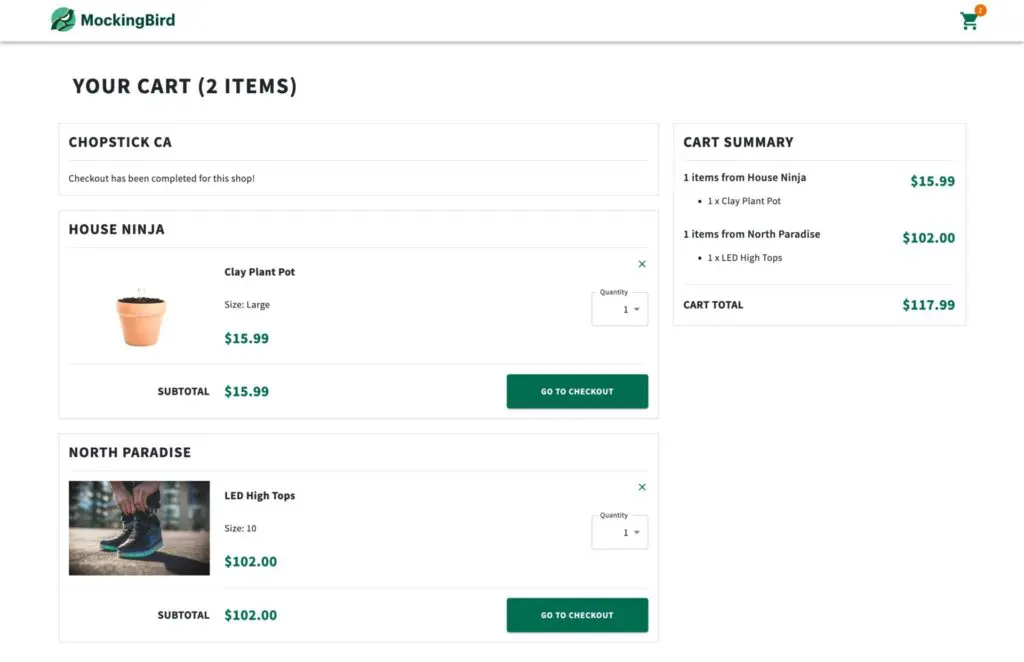
Having the images right next to the product helps customers know exactly what they are buying, preventing accidental purchases of items they don’t need, which might lead to returns later.
14. Offer Guest Checkout Options
Offer your guest customers a checkout option even though they are new to the site and have not made an account yet. Because if you don’t, they might leave without making a purchase.
Many buyers do not like to provide their information to a site they are visiting for the first time, so by letting them check out even if they don’t add their info, you make their shopping experience better and they might come back to buy more.
While this approach may not provide you with as much customer data as having them create accounts, it can significantly reduce shopping cart abandonment. According to the Baymard Institute, 25% of US online shoppers abandon their carts due to the site’s account creation requirement.
15. Social Proof and Trust Badges
Online shoppers do not want to purchase products from a site they do not trust. To establish credibility and ensure your products are perceived as legitimate, build trust among your customers.
Stats show that around 61% of customers like to buy products based on how the reviews are. And 66% of people are more likely to buy products online if they see good reviews for it and see the social proof.
You can advertise and show off how great your service is and how well-liked your products are amongst your customers. This will definitely impact your online business positively.
Boost Shopify Sales with Social Media 🤩
MAKE POSTS WITH AIWrapping It Up
Whether you’re prepared or not, cart abandonment is a significant obstacle. In a perfect world, every encounter with your brand would be completed. Unfortunately, this is not the case.
Therefore, you must have the correct tools at your disposal in order to stay one step ahead of your competition. It will ultimately help you in convincing your clients to finish the route to buy.
Make sure your product description is complete, up-to-date, and consistent across all channels. This will prevent cart abandonment during checkout.
Incorporating these effective strategies into your plan can convert reluctant browsers into decisive consumers who want to buy from you.
Since we are here, Are you looking for something much more revolutionary that will even help you make content? Sign up for Predis.ai today! Manage your social media channels and improve engagement by designing interactive posts within a few clicks.
Follow Predis.ai on Instagram for more updates on social media!
Instagram Story Ideas for eCommerce stores



